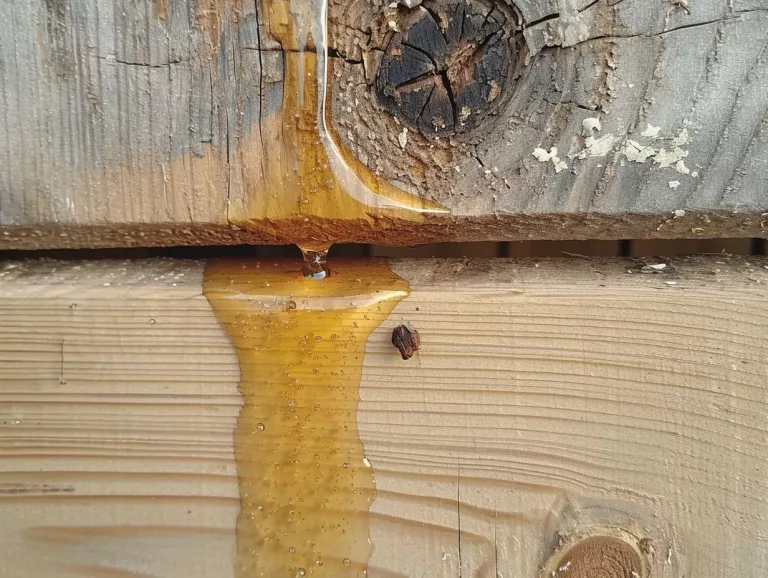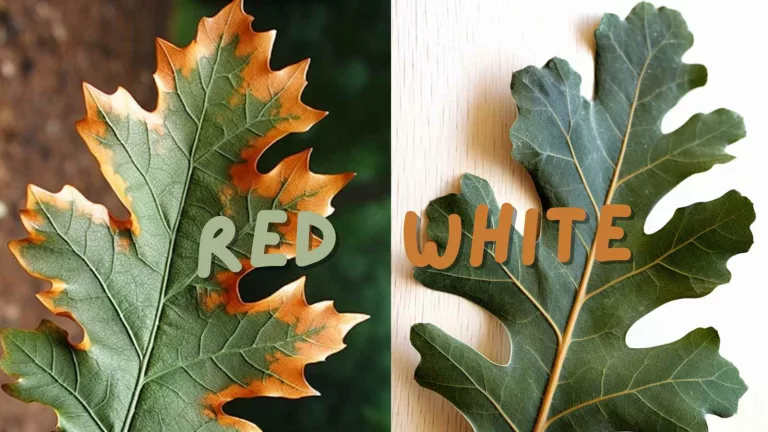How to Clean Woodwork: A Comprehensive Guide for Lasting Beauty
Hey there! Let’s try to understand How to Clean Woodwork. You might not think about it often, but keeping your woodwork clean is crucial. It’s not just about aesthetics; regular cleaning extends the life of your wood pieces and maintains their natural beauty. And don’t worry, you don’t need to be a pro to get it right. I’ve gathered some expert advice and practical tips to make your woodwork shine without the hassle.
Understanding Your Woodwork
First things first, let’s talk about what your woodwork is made of. Wood comes in various types, each with its unique characteristics and cleaning needs. For instance, softwoods like pine are more prone to scratches and require gentler cleaning methods compared to hardwoods like oak.
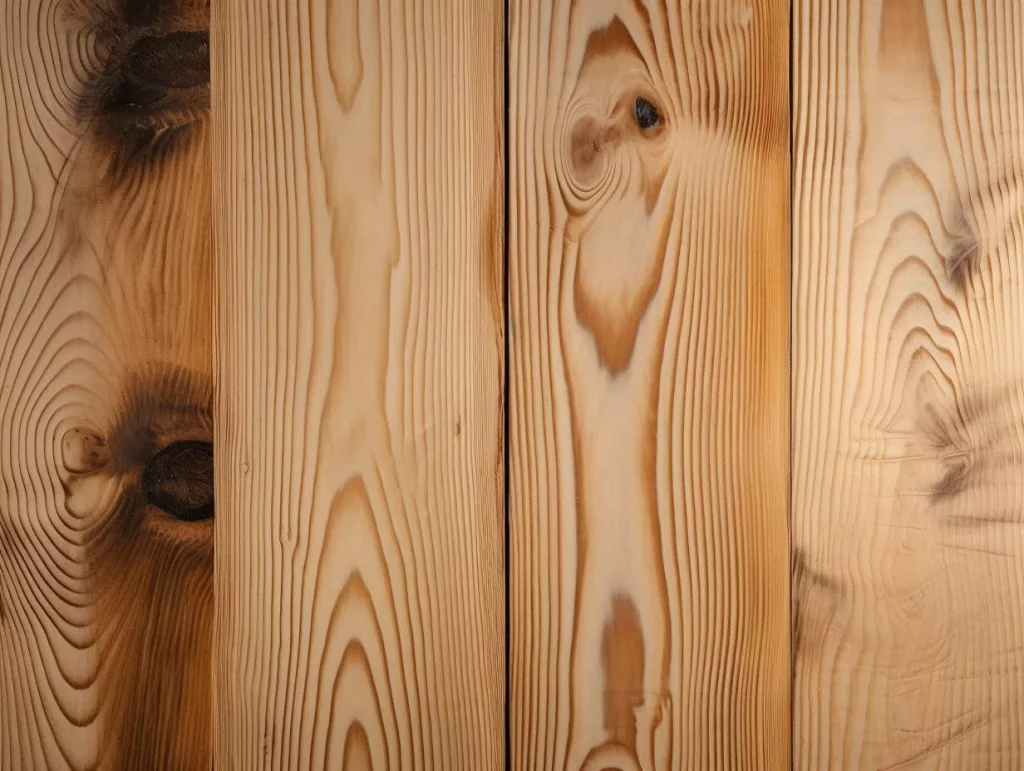
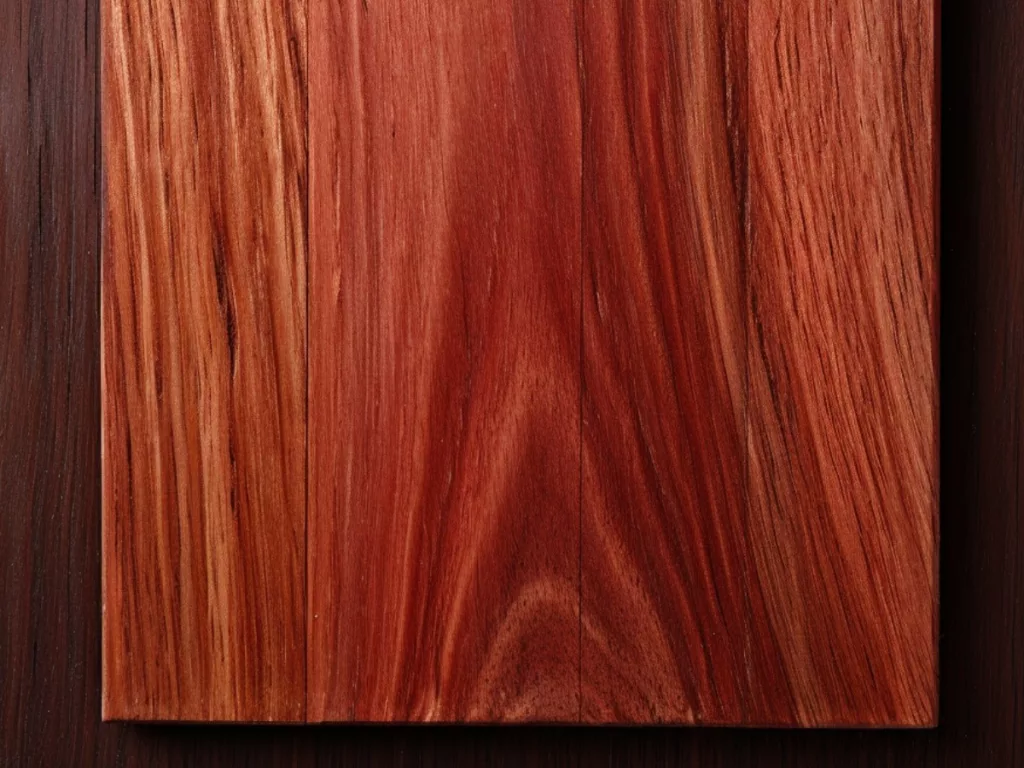
And then there’s the finish – whether it’s varnished, lacquered, or oiled, each type of finish reacts differently to cleaning agents. Knowing what you’re working with is key to effective cleaning without damaging your precious woodwork. The object may not be finished at all. Unfinished furniture are trendy now.
Moreover, check if the object you like to clean is an indoor one or an outdoor thing.
And last but not the least, check if the piece of furniture has any paints (regular/irregular) over it. Following image vividly tells about the situation.
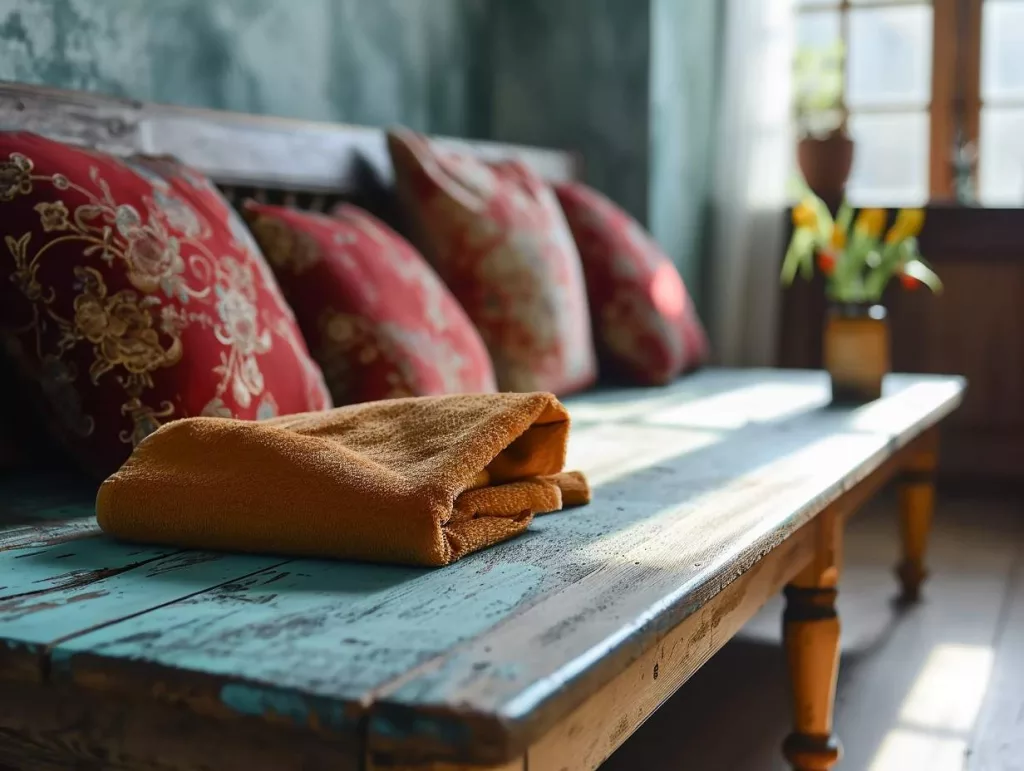
Here’s a video on cleaning any unfinished wooden thing.
Preparing for Cleaning
In this guide, I’ve focused on providing original insights and practical knowledge, steering clear of generic advice you might find elsewhere. My aim is to offer a trustworthy and expert-backed approach, ensuring the information is accurate and beneficial for you.
Remember, this is all about making your woodwork cleaning journey easier and more effective, keeping your focus on what really matters – preserving the beauty and integrity of your wood pieces. You need to ensure the following things first.
| Things you need | Reasons |
| Soft Cloths | Essential for gentle wiping without scratching the wood. A vacuum cleaner will serve the purpose as well. |
| Mild Detergent | Choose a gentle, non-abrasive detergent for safe cleaning |
| Soft-Bristled Brush | Useful for reaching into corners and intricate details |
| Avoid Harsh Chemicals | Stay away from strong, abrasive cleaners to prevent damage |
| No Abrasive Tools | Scrubbing pads or rough brushes can harm the wood’s surface |
| Safety First | Ensure good ventilation, especially when using products with fumes |
| Work in a Well-Ventilated Area | This is crucial for your safety and to avoid inhaling any strong odors |
Step-by-Step Guide to Cleaning Woodwork
Alright, let’s roll up our sleeves and get into the nitty-gritty of cleaning your woodwork. I’ll shared some tried-and-true methods and personal tricks, focusing on what really works and avoiding common pitfalls. This isn’t just about cleaning; it’s about caring for and preserving your woodwork with a touch of care. Remember, regular care keeps your woodwork looking splendid for years to come!
- Dust First: Begin with a soft, dry cloth or a microfiber duster to gently remove surface dust. This is crucial because any leftover grit can scratch the wood when you start the wet cleaning. You can use a vacuum cleaner.
- Mild is Key: Mix a few drops of mild dish soap with water. Dampen a soft cloth in the solution, wring it out well – the cloth should be damp, not wet.
- Wipe Down: Gently wipe the wood surfaces following the grain. This helps in avoiding streaks and preserves the natural pattern of the wood.
- Dry Off: Immediately after wiping, use a dry, soft cloth to remove any moisture. This step is vital to prevent water damage.
- Spot Cleaning: Got a stubborn stain? Make a paste with equal parts baking soda and water. Apply it gently on the stain, let it sit for a few minutes, and then wipe off. Always test this in an inconspicuous area first!

Routine Cleaning Techniques
For daily and weekly maintenance, simplicity is your best friend. Here’s how to keep your woodwork in top shape without overdoing it:
- Daily Dusting: Use a microfiber cloth or a feather duster to keep dust at bay. This simple step does wonders in maintaining the wood’s luster.
- Weekly Wipe-Down: Once a week, do a quick wipe-down with a damp cloth followed by a dry one, just like in the step-by-step guide above.
- Right Products: Stick to gentle cleaners. Harsh chemicals can strip the wood’s natural oils. If you’re unsure, a solution of vinegar and water is a safe bet for most finishes.
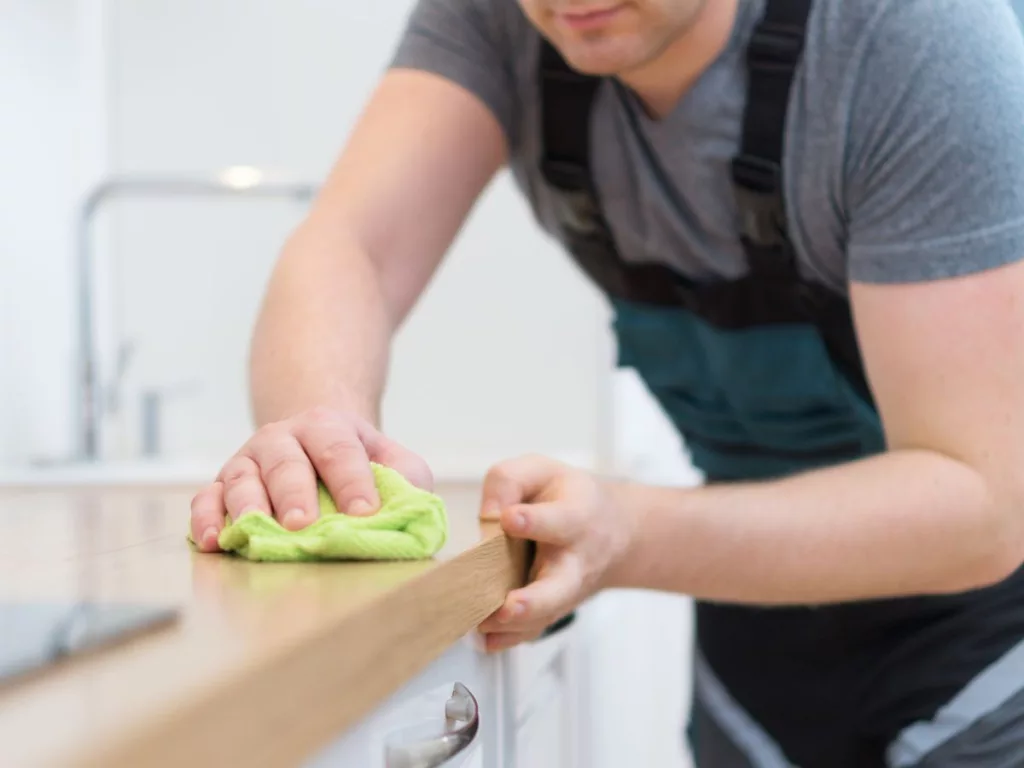
Deep Cleaning
Every once in a while, your woodwork needs a bit more love to tackle the build-up and tough stains. Here’s how:
- Prepare Your Solution: For deep cleaning, you can use a slightly stronger soap solution. But remember, gentle is still the way to go. For deep cleaning woodwork, especially when dealing with tough stains or build-up, it’s important to use a product that is effective yet gentle enough to preserve the integrity of the wood. A great solution I recommend is “Murphy’s Oil Soap.” This cleaner is well-known for its gentle cleaning power and is widely used by both professionals and DIY enthusiasts for deep cleaning woodwork.
- Tackling the Grime: Use a soft-bristled brush for intricate carvings or hard-to-reach areas. Be gentle to avoid scratches.
- Dealing with Tough Stains: For water rings, apply a little mayonnaise and let it sit for an hour before wiping. For darker stains, rubbing a bit of non-gel toothpaste mixed with baking soda can work wonders.
- Rinse and Dry: Always finish with a rinse using a damp cloth and then a dry one to prevent any soap residue.

Professional Insights
I’ve chatted with several experts and gathered some real-life stories that’ll change the way you look at wood care.
- Case Study: Antique Restoration: One of my favorite stories is about an antique restorer who brought a century-old oak table back to life. The secret? A gentle touch and patience. He meticulously cleaned the wood using mild soap and then nourished it with natural beeswax. It’s a testament to how understanding your wood’s history can guide its care.
- Expert Insight: A renowned woodworker shared that the key to maintaining woodwork isn’t just about cleaning; it’s about understanding the material. Each type of wood has its personality – some crave moisture, while others need minimal intervention.
Do’s and Don’ts for How to Clean Woodwork
Straight from the experts’ mouths, here are the cardinal rules for woodwork cleaning:
- Do: Always clean in the direction of the wood grain. This simple technique keeps the wood’s integrity intact.
- Don’t: Never use all-purpose cleaners. They can be too harsh and strip away the wood’s natural oils.
- Do: For water stains, gently rub with a mixture of oil and salt. It’s a classic trick that often works wonders.
- Don’t: Avoid soaking wood in water. Excessive moisture is the enemy of beautiful woodwork.
Enhancing the Longevity
Want your woodwork to stand the test of time? Here’s how to keep it looking splendid for years:
- Regular Dusting: It’s not just about aesthetics. Regular dusting prevents tiny particles from scratching the wood surface over time.
- Occasional Polishing: Treat your woodwork to a polish every few months. Natural oils like lemon or olive oil can add a protective sheen.
Protective Measures and Products
Finally, let’s talk about safeguarding your woodwork:
- Protective Coatings: Products like varnishes or sealants offer a protective layer against wear and tear. But remember, less is more. A thin, even coat does the job.
- Eco-Friendly Choices: Consider natural waxes like beeswax or carnauba for a sustainable, safe option. They not only protect the wood but also give it a healthy, natural glow.
Take a bit of your time for watching this video on cleaning outdoor woodworks.
Conclusion
Incorporating these expert tips and practices into your routine will not only clean your woodwork but also preserve its beauty and longevity. It’s all about nurturing your woodwork with knowledge and care, ensuring it remains a cherished part of your home for generations.
FAQs
What is the best way to wash wood?
The best way to wash wood is to use a soft cloth dampened with a mixture of water and mild detergent. Wipe along the grain, and then dry the surface immediately with a clean cloth to prevent water damage.
What is the best thing to clean white woodwork with?
For white woodwork, use a mixture of water and mild detergent, or a solution of equal parts vinegar and water. Apply with a soft cloth, gently scrubbing any stains, and then wipe dry. For tougher stains, a non-abrasive cleaner like baking soda mixed with water can be effective.
How to clean white painted woodwork?
To clean white painted woodwork, gently wipe it with a soft cloth dampened with a mixture of warm water and mild dish soap. For tougher stains, a solution of baking soda and water can be used. Always finish by wiping with a dry cloth to prevent moisture damage.



